Mill Express CAM Tutorial
Introduction
This tutorial explains how to create the machining program for the Mill Express demonstration file. The process includes creating geometry that is used to create the stock. The outside of the model is then roughed and finished with profile operations. Next, the pocket is roughed, finished, and a chamfer operation is applied to break the top edge. Finally the holes are drilled before simulating the program to confirm the results.
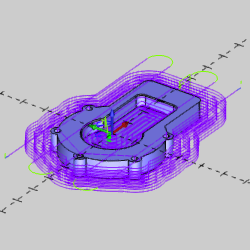
This tutorial highlights the following functionality of the BobCAD-CAM software:
- Creating a milling job, stock, assigning the workpiece for simulation, and setting the machining origin
- Selecting a stock material to determine automatic feeds and speeds calculations
- Creating 2 Axis features for:
- Facing
- Profiling
- Pocketing
- Chamfering
- Using Modify Start Point for 2 Axis operations
- Creating Mill Drill Hole features
- Using the CAM Wizards to guide you through creating machining features
- Selecting tools from the Tool Library and Tool Crib
- Utilizing CAD layers for creating and selecting feature geometry
- Using loop selection with a solid model
- Using Pick options to set Feature parameters
- Tips for easier viewing of computed toolpaths
- Verify the Operation Order
- Simulating the program
Part 1) Open the Example File and Save As
The first step is to open the finished Mill Express CAD model from the Demo Files folder, and then use Save As to rename the file. It is good practice to properly name your files and save them often.
- In the Quick Access Toolbar, at the top left of the application, click
 Open an existing document.
Open an existing document.
- Navigate to C:\BobCAD-CAM Data\BobCAD-CAM **Current Version**\Examples\Demo Files, and select Mill Express CAD.bbcd.
- Click Open.
- In the Quick Access Toolbar at the top left of the software, click
 Settings to launch the Settings dialog.
Settings to launch the Settings dialog.
The Settings dialog launches.
- In the System tab, click CAM to open the CAM page.
- In the CAM Tree group, select the check box for Auto Blank New Items, and set the Look and Feel to Extended / Right.
This ensures job stock and operation toolpath is defaulted to blank on creation, and extended look and feel allows us to control blank and post options with icons.
- In the Quick Access Toolbar, click
 Save As.
Save As.
- Select or create a new folder to save to, or just use the Demo Files folder.
- Change the File Name to Mill Express CAM, and click Save.
Part 2) Create Stock Geometry
In this part, we create geometry to allow us to determine the stock by selecting geometry.
Note: While you can also set a size to your stock without the need for geometry, we use the geometry selection method in this tutorial.
- Right-click in the Layers Manager, and click Add New Layer.
The layer is created as an active layer with the name highlighted to allow for edits.
- To name the layer, type Facing.
Create a Rectangle
- In the Shapes group, of the Create 2D ribbon, click
 Rectangle.
Rectangle.
The Rectangle dialog appears in the Data Entry Manager, with the Rectangle Center Creation Option selected.
- Update the Data Entry parameters:
- In the Dimensions group:
- Length = 6.500
- Width = 4.250
- In the Base Point group:
- X = 0.875
- Y = 0.000
- Z = 0.000
- Option =
 (Center)
(Center)
- In the Corner Type group:
-
 (Sharp Corner)
(Sharp Corner)
- Click OK to create the rectangle.
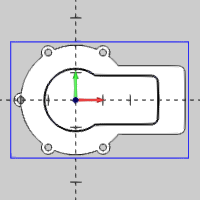
- Click Cancel.
- Click in the graphics area, to give it focus, and press Ctrl+7 to enter the ISO 2 View.
Part 3) Create a CAM Job
The process of creating a CAM Job in BobCAD-CAM includes selecting the type of job and machine. You can then go directly to defining the stock geometry.
- To create a new CAM Job, do one of the following:
- In the CAM Job group of the CAM ribbon, click
 New Job.
New Job.
- In the Quick Access Toolbar of the CAM Tree Manager, click
 .
.
- In the CAM Tree Manager, right-click
 CAM Defaults, and click New Job.
CAM Defaults, and click New Job.
- Under Job Type, select Milling.
- under Machine, select BC_3X_Mill.
- Click Stock Wizard.
Part 4) Assign the Workpiece and Create Stock
Assign the Workpiece for Simulation
When you start the stock wizard form the Machining Job dialog box, the Workpiece dialog box displays before the stock wizard. This is used to assign the geometry that we want to use as the workpiece when we simulate the program.
- With the Workpiece dialog launched, the Selected Geometry list automatically has focus.
Click to select the model in the graphics area.
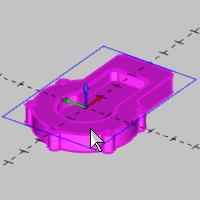
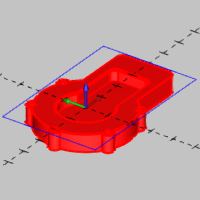
- Click
 to move to the Stock Definition page.
to move to the Stock Definition page.
Create Stock
The Stock Wizard is a powerful stock creation tool which can automatically detect geometry in the graphics area to speed up stock creation.
- The default setting, Geometry from Graphics Area, automatically creates stock geometry based on the CAD model. (With both wireframe and a solid in the graphics area, Geometry from Graphics Areas detects the solid.)
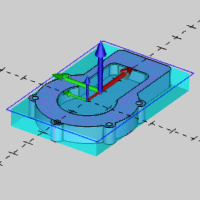
We could use the Offset parameters to increase the size of the automatically created stock, but for this example we pick the rectangle and then adjust only one parameter.
Under Geometry Options, click Pick.
The Selected Geometry list automatically has focus.
-
By default, the Picking Manager is set to Auto-Connection, make sure the Tangent Propagation option is off, and click one of the entities which comprises the rectangle to select the entire chain.
The geometry is added to the Selected Geometry list.
- Click Calculate Stock.
- Now we add stock above the top face of the model that is removed by a facing operation.
In the Dimension / Offset group, change the Offset + / Z value to 0.100. (Press Tab to update the stock preview.)
- Click
 .
.
Note: Now that the stock has been created, there is no longer a need for the rectangle we just used, and so the Facing layer can hidden.
Part 5) Select the Machining Origin
The Machine Setup is an important part of creating CAM Jobs in BobCAD-CAM. This includes setting the work offset number, clearance plane, and machining origin for each setup that you need on the physical machine.
- In the Machine Setup dialog, under the Setup Orientation section, in the Coordinate System group, there is another group; Origin. In this group, click in the list box to give it focus.
- Select the machining origin at the top corner of the stock.
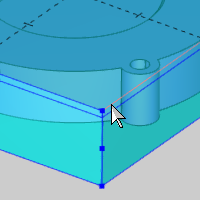
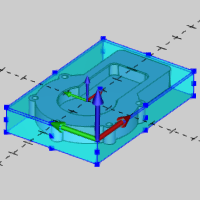
Note: This step defines the machining origin (work offset) location for the machining features that you create. The machining origin is independent of the CAD origin, and should be placed in the same location as the work offset location on the physical stock.
- Click Work Offset. Leave the default for Work Offset # at 1(G54).
Important: Notice the XYZ values. These are important to create proper simulation when using Machine Simulation Pro. By default, the Machining Setup, will be placed at the virtual machine zero in simulation. Usually the virtual machine zero will be flush with the center of the table. With our stock existing below our Machine Setup, our simulation, in Machine Simulation Pro, will appear to be sitting inside of the machine table. Setting values for our Work Offset, will adjust for this, and show the difference from the virtual (and therefore actual) machine zero, to our work offset (G54).
- Update the values:
- X = -3.250
- Y = -2.125
- Z = 3.000
- Click OK.
- Use the default Clearance Plane value of 1.000, and click OK.
The Milling Job is created with the defined stock and machine setup information.
- Save the file.
Part 6) Select the Stock Material
Selecting the appropriate stock material for the job determines the values used for automatic speeds and feeds calculations in the Milling Wizard. This information can be customized using the Stock Material Library.
- In the CAM Tree, click the
 icon next to
icon next to  Stock to view the material.
Stock to view the material.
- Right-click the current
 Stock Material, and click Edit.
Stock Material, and click Edit.
The Stock Material Library launches.
- Under Material Group, select Aluminum.
- In the Material List, click Material Type to sort the list.
- Select Wrought Alum 6061-0.
- Click OK.
Part 7) Create Mill Facing Feature
To begin creating our machining program, we create a Mill Facing feature with a single facing operation.
Note: In this tutorial, we use many of the default settings and only update them as needed. If you want more information about particular settings, view the BobCAD-CAM Help System.
Add the Feature and Select Geometry
- Right-click
 Machine Setup, and click Mill Facing.
Machine Setup, and click Mill Facing.
The Mill Facing Wizard launches.
- Click Next>> to move on to the Feature page.
The Feature page contains the Material Approach, Feature Parameters, and Parameters groups. In this case we will be using the defaults for the Clearance, Rapid, and Feed Planes. The Top of Feature and the Total Depth have already been set in the Feature Geometry Picking dialog. That leaves us only with the Extension options which are not necessary in this case.
Note: By default, the Mill Facing feature analyzes the Job Stock, and the selected Workpiece to determine the proper geometry and depth of cut for the Facing feature.
- Since we are not making any changes to the Feature page, click Next>> again to move to the Machining Strategy page.
Select the Machining Strategy
- Notice that selecting this operation template adds a single Facing operation to the Current Operations list.
Click Next>> to go to the Posting settings.
Confirm the Posting Settings
Notice Work Offset #1 (G54) is automatically selected as we defined in the Machine Setup.
- Click Next>>.
Select the Facing Tool
- Under Tool Data, change the Diameter to 2.000, and press Tab.
Notice that the 2 inch face mill is automatically pulled from the Tool Library because the System Tool check box is selected.
- Click Next>>.
Set the Operation Parameters
- Under
 Patterns, change the Distance values to 0.125.
Patterns, change the Distance values to 0.125.
For the Parameters and Leads settings, we use the default values.
- In the tree on the left, click Links.
- Under Link, click Arc to create a smooth transition between each pass of the operation.
Compute the Toolpath
- At the bottom of the Mill 2 Axis Wizard, click Compute.
- Press Ctrl+S to save the file.
Tips for Easier Viewing of Toolpath
Next we hide geometry that we don't need and explore how the CAM Tree visibility options can make viewing of toolpath easier. These steps are especially helpful as the number of operations in the program increases.
- In the Layers Manager, in the Solids row, click in the active column to set Solids as the active layer.
- Next to Facing, click
 to hide the layer, since we are done with our stock geometry.
to hide the layer, since we are done with our stock geometry.
We modified the layers to make it easier to view the computed toolpath.
- Under
 Feature Mill Facing, click Facing.
Feature Mill Facing, click Facing.
- The hidden toolpath displays in the graphics area until you click another tree item.
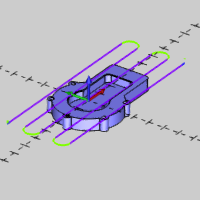
Tip: All feature items in the tree (Feature, Geometry, and Start Point) as well as the operation items highlight the corresponding feature information in the graphics area when you click them.
- Next to
 Feature Mill Facing, click
Feature Mill Facing, click  to collapse the feature.
to collapse the feature.
This is helpful to reduce the need for scrolling through the CAM Tree as the number of features increase.
Part 8) Create a 2 Axis Feature for Profiling
The next feature that we create, will rough and then finish the outside of the model with two profile operations.
Add the Feature and Select Geometry
- In the Machining Features of the Milling ribbon, click the down arrow to bring the
 Mill 2 Axis Feature icon into view.
Mill 2 Axis Feature icon into view.
Click the  Mill 2 Axis Feature icon to launch the Mill 2 Axis Wizard.
Mill 2 Axis Feature icon to launch the Mill 2 Axis Wizard.
The Mill 2 Axis Wizard launches.
- Click Select Geometry.
The Feature Geometry Picking launches in the Data Entry Manager.
The focus is automatically on the Selected Geometry list and selection mode is active to allow you to begin selecting geometry for the feature.
-
Click on the top outer edge of the model, as seen in the images below.
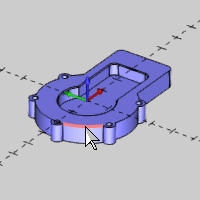
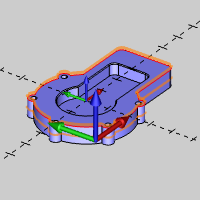
The selected entities are added to the Selected Geometry list, and a chain is added to the Profile Chains list.
With geometry selected, the feature preview appears, which shows the top and depth of the feature.
- At this stage, it is also possible to set the Chain Start Point and direction.
In the Profile Chains list, select the chain.
The chain highlights in the graphics area, and the start point becomes visible.
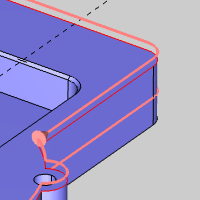
- To move the start point, click on, or near the beginning, middle, or end of an entity in the chain.
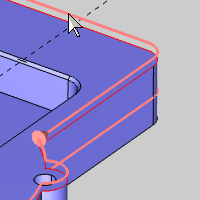
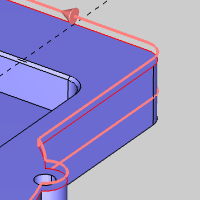
- To reverse the direction, click on, or near the current location of the start point.
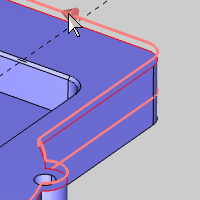
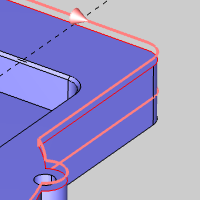
The start point and direction of the chain are now set.
Tip: The chains can also be reversed by selecting the  (Reverse) button, next to the Profile Chains list.
(Reverse) button, next to the Profile Chains list.
- In the Top of Feature group, click in the Pick Top list.
Focus is shifted to the Pick Top list.
- Click the top edge of the model as shown in the image below.
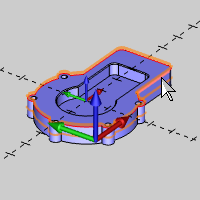
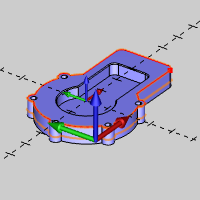
The point is added to the Pick Top list and the depth value and feature preview are updated.
- In the Total Depth group, click in the Pick Bottom list.
Focus is shifted to the Pick Bottom list.
- Click the bottom edge of the model as shown in the image below.
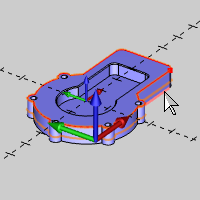
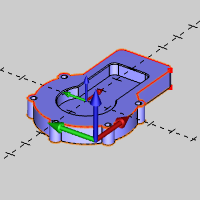
The point is added to the Pick Bottom list and the depth value and feature preview are updated.
- Right-click anywhere in the graphics area, and click OK.
- Click Next>> twice to move to the Machining Strategy page.
Select the Machining Strategy
- The default strategy, Profiling, contains one Profile Rough operation and one Profile Finish operation as shown in the Current Operation list. This is the appropriate strategy for this feature.
Select the Profile Rough Tool
- In the tree under
 Profile Rough, click
Profile Rough, click  Rough.
Rough.
- Click Tool Crib.
- By default, the Tool Category should be set to
 Endmill Rough.
Endmill Rough.
In the Tool Library window, at the bottom of the Tool Crib, click the column name Diameter to sort the tool list.
- Drag, and drop, the 0.500 inch diameter flat endmill with the 1.125 inch flute length into the Tool Crib window. (Tool Label: 1/2 Flat Rough Endmill - Standard)
You can also highlight the tool, and select Add Selected Tools From Library.
- Click the tool in the Tool Crib window to select it for the operation.
- Click OK in the Tool Crib.
All Tool Data is automatically updated with the information from the Tool Library.
- Click Next>>.
Set the Operation Patterns
- Under
 Patterns, click Side Roughing.
Patterns, click Side Roughing.
- Change the Stock Remaining value to 1.000
- Change the Number of Passes to 3.
- Click Next>>.
Set the Operation Parameters
- We are using the default Side Allowance of 0.015 to leave material for the finishing operation.
Under Depth, click Multiple Steps.
- In the Depth of Cut box, type 0.750/6, and press Tab. The software calculates the value.
For the remaining operation pages, Leads, Corner types, and Machine Sequence, we use the default settings.
Select the Profile Finish Tool
- Under
 Profile Finish, click
Profile Finish, click  Finish.
Finish.
- Click Tool Crib.
- By default, the Tool Category should be set to
 Endmill Finish.
Endmill Finish.
In the Tool Library window, at the bottom of the Tool Crib, click the column name Diameter to sort the tool list.
- Click the column name Diameter to sort the tool list.
Drag, and drop, the 0.125 inch diameter flat endmill with the 1.000 inch flute length into the Tool Crib window. (Tool Label:1/8 Flat Endmill - Long)
- Select the new tool to set it as the active tool in the operation.
- Click OK in the Tool Crib.
Set the Operation Leads
- Under
 Profile Finish, click
Profile Finish, click  Leads.
Leads.
- Under Lead-in, click Circular.
Notice that the Lead-out is automatically set to use the same settings because Same as Lead-in is selected.
- Under Lead-out, change the Overlap Amount to 0.050.
This helps to remove any scallop that may be created by leading in and out from the same location.
For this operation, no changes are needed for the Corner Types or Machine Sequence.
Compute the Toolpath
- Click Compute.
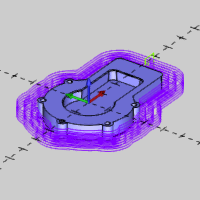
- Next to the new
 Feature 2 Axis, click
Feature 2 Axis, click  to collapse the feature.
to collapse the feature.
- Save the file.
Part 9) Create a 2 Axis Feature for Pocketing.
The final 2 Axis feature is created to rough and finish the pocket and to cut a chamfer. This is a special case for 2-axis features as BobCAD-CAM allows you to define the chamfer depth separately from the other operations in the feature, which eliminates the need for an extra feature.
Add the Feature and Select Geometry
- Right-click
 Machine Setup, and click Mill 2 Axis.
Machine Setup, and click Mill 2 Axis.
The Mill 2 Axis Wizard launches.
Tip: Notice feature creation can be accomplished through the Machine Setup, or by selecting icons from the Machining Features section of the Milling contextual ribbon.
- Click Select Geometry.
The Feature Geometry Picking dialog launches in the Data Entry Manager.
The focus is automatically on the Selected Geometry list and selection mode is active to allow you to begin selecting geometry for the feature.
- Click the bottom for the pocket, as seen in the image below.
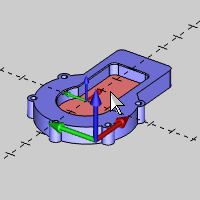
The software automatically extracts the edges of the selected surface to use for the feature.
The selected geometry is added to the Selected Geometry list, and a chain is added to the Profile Chains list.
With geometry selected, the feature preview appears, which shows the top and depth of the feature.
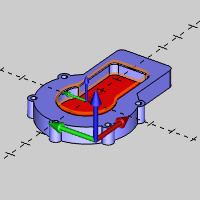
- In the Top of Feature group, click in the Pick Top list.
Focus is shifted to the Pick Top list.
- Click the top edge of the model as shown in the image below.
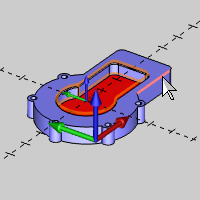
The point is added to the Pick Top list and the depth value and feature preview are updated.
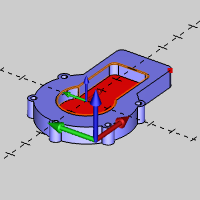
The default depth is what we need in this case, so we will not need to adjust it.
- Click OK to confirm the geometry selection and return to the Mill 2 Axis Wizard.
- In the tree on the left, click
 Machining Strategy.
Machining Strategy.
Select the Machining Strategy
- Under Default Strategy, select Pocketing.
- Under Current Operation, click Profile Finish to select the insert location, in order to have an operation added below the Profile Finish.
- Under Available Operations, click Chamfer Mill, and click
 to add the operation to the Current Operations list.
to add the operation to the Current Operations list.
- Click Next>> to update the tree with the new operations.
Select the Pocket Tool
- Under
 Pocket, click
Pocket, click  Rough.
Rough.
- Click Tool Crib.
- By default, the Tool Category should be set to
 Endmill Rough.
Endmill Rough.
In the Tool Library window, at the bottom of the Tool Crib, click the column name Diameter to sort the tool list.
- Drag, and drop, the 0.375 inch diameter flat endmill with the 0.875 inch flute length into the Tool Crib window. (Tool Label: 1/2 Flat Rough Endmill - Standard)
- Click the tool in the Tool Crib window to select it for the operation.
- Click OK in the Tool Crib.
All Tool Data is automatically updated with the information from the Tool Library.
Set the Operation Parameters
- Under
 Pocket, click
Pocket, click  Parameters.
Parameters.
- Under Depth, click Multiple Steps.
- Update the Depth of Cut value to 0.200, and press Tab.
Notice the software automatically calculates the value to create Even Depths of 0.1667.
- Click Next>>.
Set the Operation Leads
- Select Ramp, and use the default Ramp Length and Angle of Approach values.
Select the Profile Finish Tool
- Under
 Profile Finish, click
Profile Finish, click  Finish.
Finish.
Notice that the software automatically selected the previous finishing tool from the Tool Crib (1/8 Flat Endmill - Long).
Set the Operation Leads
- Under
 Profile Finish, click
Profile Finish, click  Leads.
Leads.
- Under Lead-in, select Circular.
- Under Lead-out, change the Overlap Amount to 0.050.
- At the bottom left of the wizard, click Apply to All Operations.
This will set the leads on our Chamfer Mill with the same settings.
Select the Chamfer Tool
- Under
 Chamfer Mill, click
Chamfer Mill, click  Chamfer Mill.
Chamfer Mill.
- Click Tool Crib.
- By default, the Tool Category should be set to
 Chamfer Mill.
Chamfer Mill.
Drag, and drop, the 0.250 inch diameter chamfer endmill (Tool Label: 1/4' Chamfer Endmill) into the Tool Crib window.
- Select the new tool to set it as the active tool in the operation.
- Click OK in the Tool Crib.
All Tool Data is automatically updated with the information from the Tool Library.
Set the Operation Parameters
Important: For 2 Axis features, the Total Depth from the Feature settings is not applied to Chamfer operations (or Corner Rounding). These operation types have their own Depth in the operation Parameters. This is done to allow you to use these operations without the need to create a separate feature.
- Under
 Chamfer Mill, click
Chamfer Mill, click  Parameters.
Parameters.
- Under Depth, click Pick Bottom.
The Pick Bottom dialog opens in the Data Entry Manager, with focus on the Selected Geometry list.
- Click the lower surface edge of the chamfer.
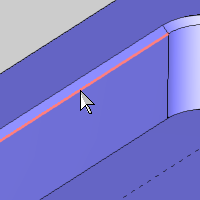
- Click OK.
- The Depth is updated to 0.0354.
Compute the Toolpath
- Click Compute.
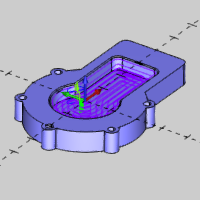
- Collapse the feature.
Part 10) Create a Mill Drill Hole Feature
Add the Feature and Select Geometry
- Right-click
 Machine Setup, and click Mill Drill Hole.
Machine Setup, and click Mill Drill Hole.
The Mill Hole Wizard launches.
- Click Select Geometry.
- In the Layers Manager, click in the
 column of the Holes row to show the layer.
column of the Holes row to show the layer.
- In the Quick Selection group of the Home ribbon, click the drop down for
 Pick By Layer, and select
Pick By Layer, and select  Pick By Layer.
Pick By Layer.
- Select the Holes layer.
- Click OK.
The geometry is added to the Selected Geometry list.
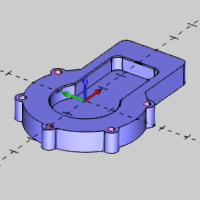
- Under Point and Arc Usage, click Use as Top.
This setting allows the software to automatically set our Top of Feature value in the wizard based on our selection.
- Click OK to confirm the selection.
The Hole Diameter is automatically set for the selected holes.
- Click Next>>.
Set the Feature Parameters
After selecting our geometry, the software automatically groups all the holes into a single hole group. All holes in a hole group share the same Top of Feature and Feature Depth. Our Top of Feature is already set, since we utilized the Use As Top option in the Hole Geometry Picking dialog, so next we select our depth for the hole group.
- Under Hole Groups, click Pick Bottom.
The Pick Bottom dialog appears.
- Click the lower surface edge of the model.
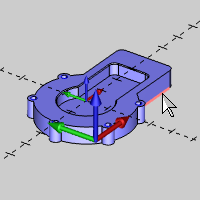
- Click OK.
Under Parameters, notice the Hole Type is set to Through Hole. We use this setting because the holes go completely through the model and this changes the depth calculation accordingly.
- Click Next>>.
Select the Machining Strategy
- Under Default Strategy, select Hole.
This operation template adds one Center Drill and one Drill operation to the Current Operations list.
- Click Next>> to update the tree with the new operations.
Set the Operation Parameters
- In the tree on the left, click
 Center Drill to go to the tool page.
Center Drill to go to the tool page.
- Notice that System Tool is selected which automatically picks an appropriate tool from the Tool Library after, first, searching the Tool Crib.
We use the default Center Drill Parameters, and we use System Tool again for the Drill operation.
- In the tree under
 Drill, click
Drill, click  Parameters.
Parameters.
- Under Cycle Type, click Peck.
Compute the Toolpath
- Click Compute.
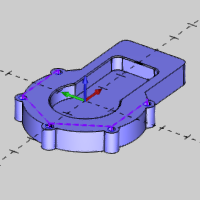
- Press T to turn on the transparent view and make it easier to view the toolpath. Pressing T again will turn off the transparent view.
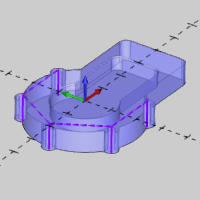
- In the Layers Manager, click
 to hide the Holes layer.
to hide the Holes layer.
- Click the visibility icon next to
 Machine Setup, to show all hidden toolpath.
Machine Setup, to show all hidden toolpath.
Before simulation and the posting of code, it is a good idea to verify proper tooling and the posting order of your operations. Starting with version 35 the Machining Order dialog has been retired in favor of the new operation tree.
-
In the Operations Manager and click the  icon to view the Tool Tree.
icon to view the Tool Tree.
Notice the job is listed at the top with the operation count next to it. Multiple jobs can be seen here if they exist in the file.
-
Take a second to verify the proper tools are being used for the job, and the proper operations are assigned to each.
Important: If a tool is noticed to have been signed incorrectly, you can right-click it to edit a particular parameter of the tool, or click replace to change the tool completely. If an operation is seen to be assigned to the wrong tool, the operation can be dragged to another tool and then recomputed.
-
Click the  icon to view the Operation Tree.
icon to view the Operation Tree.
Notice, just like the Tool Tree, the job is listed at the top with the operation count next to it. Multiple jobs will be seen here as well if they exist in the file.
-
Take a second to verify the operations are in the proper order for posting.
Right-clicking the operation will access the context menu allowing you several options including editing the operation, and adjusting its posting order.
Tip: For more information on the Tool Tree, see the Tool Tree topic in the help system. For more information on the Operation Tree, see the Operation Tree topic.
Part 12) Simulate the Program
Now that we have finished creating the CAM features, the next step is to simulate the program to check for an necessary changes.
- In the Simulation group, of the Milling ribbon, click
 Start Simulation.
Start Simulation.
- In the Simulation group on the Simulation ribbon, the third icon to set the focus will show as either
 Tool,
Tool,  Machine, or
Machine, or  Workpiece/Stock, with a down arrow to choose between them.
Workpiece/Stock, with a down arrow to choose between them.
Which icon is shown depends on what you were using last. Make sure the icon is set to  Workpiece/Stock.
Workpiece/Stock.
- Click the down arrow under
 Visibility, and make sure the
Visibility, and make sure the  Toolpath button is not highlighted. This will hide the toolpath to make the cut stock easier to see.
Toolpath button is not highlighted. This will hide the toolpath to make the cut stock easier to see.
- Click
 to run the simulation, and adjust the
to run the simulation, and adjust the  speed slider as needed.
speed slider as needed.
- In the Simulation group of the Milling ribbon, click
 Stop Simulation.
Stop Simulation.
Congratulations! You have completed the CAM portion of the Mill Express demonstration file.
Next Topic
To learn more about simulation, view Getting Started with Simulation.


 Settings to launch the Settings dialog.
Settings to launch the Settings dialog.
 .
.




 icon next to
icon next to 
 to collapse the feature.
to collapse the feature.






![]() (Reverse) button, next to the Profile Chains list.
(Reverse) button, next to the Profile Chains list. 




 to collapse the feature.
to collapse the feature.



 Chamfer Mill.
Chamfer Mill. Chamfer Mill.
Chamfer Mill. 

 Pick By Layer, and select
Pick By Layer, and select  Pick By Layer.
Pick By Layer. 

 Center Drill to go to the tool page.
Center Drill to go to the tool page.

![]() icon to view the Tool Tree.
icon to view the Tool Tree. ![]() icon to view the Operation Tree.
icon to view the Operation Tree. Start Simulation.
Start Simulation. Tool,
Tool,  Machine, or
Machine, or  Workpiece/Stock, with a down arrow to choose between them.
Workpiece/Stock, with a down arrow to choose between them. Workpiece/Stock.
Workpiece/Stock. Visibility, and make sure the
Visibility, and make sure the  Toolpath button is not highlighted. This will hide the toolpath to make the cut stock easier to see.
Toolpath button is not highlighted. This will hide the toolpath to make the cut stock easier to see. Stop Simulation.
Stop Simulation.